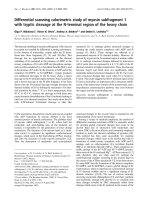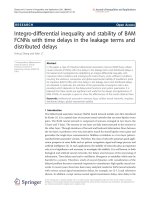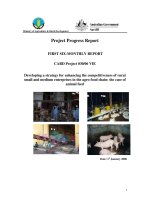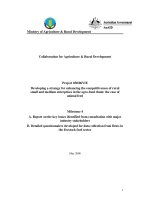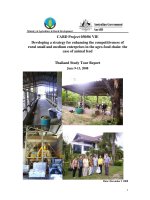Connectivity of logistics chain of Nippon Express Hanoi with Vietnamese enterprises in the period 2015-2021 and outlook to 2025
Bạn đang xem bản rút gọn của tài liệu. Xem và tải ngay bản đầy đủ của tài liệu tại đây (618.12 KB, 77 trang )
N
A
M
E
C
ao
Vi
nh
Q
ua
ng
M
A
J
O
R:
In
te
rn
ati
on
al
B
us
NATIONAL ECONOMICS UNIVERSITY
ADVANCED EDUCATIONAL PROGRAMS
BACHELOR THESIS
International Business
Topic: Connectivity of logistics chain of Nippon
Express Hanoi with Vietnamese enterprises in the
period 2015-2021 and outlook to 2025
Cao Vinh Quang
Y
E
A
R:
20
Hanoi - 2022
NATIONAL ECONOMICS UNIVERSITY
ADVANCED EDUCATIONAL PROGRAMS
BACHELOR THESIS
Topic: Connectivity of logistics chain of
Nippon Express Hanoi with Vietnamese
enterprises in the period 2015-2021 and
outlook to 2025
Student: Cao Vinh Quang
Speciality: International Business
Class: International Business
Administration 60B Student’s ID:
11184159
Supervisor: Assoc.Prof.Dr. Bui Huy
Nhuong
HÀ NỘI – 2022
ACKNOWLEDGEMENTS
First of all, I would like to thank all the Board of
Directors of National Economics University and
the teachers in the Institute of Advanced, High
Quality & POHE for creating conditions for me
to study and work. accumulate knowledge in the
best environment. Thank you, teachers, for your
enthusiastic teaching to help the author could
learn and equip myself with valuable baggage.
During the time since starting the thesis, I have
received the attention, guidance and help of
Assoc. Dr. Bui Huy Nhuong. I would like to
express my sincere thanks to the teacher who
has been very enthusiastic in supporting,
encouraging, and guiding me to carry out and
complete the thesis.
My sincere gratitude to Mr. Nguyen Van Chinh,
General Manager of Transportation Department
at Nippon Express Hanoi Branch for giving me a
chance to do my internship in the Tranportation
Department and Logistics Department.
Lastly, I would like to thank Ms. Dang My Linh,
leader of the group for her useful information and
support.
Author
2
STATUTORY DECLARATION
I, Cao Vinh Quang, hereby declare that this research is an independent
work done by myself. The information and data analyzed and used in the
research are completely honest, have clear origins and are published in
accordance with regulations.
Some conclusions in the research paper are inherited from previous
studies, some are new findings of the research team made on the basis of
honest and objective investigation and analysis, which is practical in
accordance with the Vietnamese context.
I take responsibility for my promises.
Hanoi, …. /.…. / 2021
Signature
TABLE OF CONTENT
ACKNOWLEDGEMENTS.....................................................................................3
STATUTORY DECLARATION..............................................................................2
ABBREVIATIONS.................................................................................................6
LIST OF FIGURES..............................................................................................7
LIST OF TABLES..................................................................................................7
Warehouse system...................................................................................................7
INTRODUCTION..................................................................................................9
1.
Significance of the study.........................................................................9
2.
Research Objectives & Research Task..........................................................10
2.1. Research Objective...............................................................................10
2.2. Research task........................................................................................10
3.
Object and scope of the study........................................................................11
3.1. Object....................................................................................................11
3.2. Location................................................................................................11
3.2.1. Duration................................................................................................11
4.
Research method...................................................................................11
5.
Organization of the study......................................................................11
6.
Contributions:.......................................................................................11
CHAPTER 1: GENERAL THEORY OF CONNECTIVITY OF LOGISTICS
CHAIN BETWEEN FOREIGN CORPORATIONS AND DOMESTIC
ENTERPRISES....................................................................................12
1.1.1
Content of conectivity..........................................................................13
1.1.2.1 Connectivity of infrastructure...................................................................13
1.1.2.2 Connectivity of service..............................................................................15
1.2.
Factors affecting to logisctics..............................................................15
1.2.1.
Enterprise Factors...............................................................................15
1.2.2.
National factors...................................................................................17
1.2.2.3. International competition........................................................................18
CHAPTER 2 : RESEARCH METHODOLOGY............................................19
2.1. Research design............................................................................................19
2.2 Information collection....................................................................................20
2.2.1. Sources of information to be gathered:.....................................................20
2.2.1.1 Secondary data source..............................................................................20
2.2.1.2 Primary data source..................................................................................20
2.2.2. Planning for information collection:........................................................20
2.3 METHODS OF INFORMATION PROCESSING AND ANALYSIS............21
Chapter 3: : THE CURRENT SITUATIONS OF CONNECTIVITY OF
LOGISTICS CHAIN OF NIPPON EXPRESS (JAPAN) WITH
VIETNAMESE ENTERPRISES IN THE PERIOD 2015-2021................23
3.1.2. The process of establishment and development of enterprises:.............23
3.1.2.1. Establishment:.......................................................................................23
3.1.2.2. The organization structure of the company:........................................26
3.1.2.3. General performance of Nippon Express Limited Company, Hanoi
Branch..................................................................................................................28
3.2.
Connectivity capacity of Vietnamese Enterprises..................................30
3.2.1.Connectivity Capacity of Vietnamese Enterprises.......................................30
3.2.1.1. Capacity for Human Resources...............................................................30
3.2.1.2
. Capacity for infrastructure................................................................31
3.2.1.3. Capacity for logistics services..................................................................34
3.3.
Current situations of Connectivity of logistics chain of Nippon
Express with Vietnamese Enterprises...................................................................41
3.3.1.
Connectivity of infrastructure.............................................................41
3.3.2.
Connnectivity of services.....................................................................45
3.3.2.1.
Service quality......................................................................................45
3.3.2.2.
Service Efficiency................................................................................46
3.4.
Evaluate the Connectivity situation of Nippon Express with
Vietnamese Enterprises.........................................................................................51
3.4.1.
Overall results......................................................................................51
3.4.2.
Limitations...........................................................................................53
3.4.3.
Reasons for limitations.......................................................................55
3.4.3.1.
Objective reasons................................................................................55
3.4.3.2.
Subjective reasons................................................................................57
CHAPTER 4: ORIENTATIONS AND SOLUTIONS TO PROMOTE THE
CONNECTIVITY OF LOGISTICS CHAIN OF NIPPON EXPRESS
(JAPAN) WITH VIETNAMESE ENTERPRISES....................................59
4.2.
Solutions to promote the Connectivity of logistics chain of Nippon
Express with Vietnamese Enterprises...................................................................60
4.2.1.
Invest to upgrade infrastructure and logistics services of Vietnamese
Enterprises to the standards of Nippon Express..................................................60
4.2.2.
Develope an effective online logistics chain platform.........................61
4.2.3.
Improve the quality of Vietnamese human resources to the standards
of Nippon Express.................................................................................................61
4.2.4.
Improve competitiveness in connectivity.............................................65
4.3.
Recommendations................................................................................65
4.3.1.
Recommendations to the Vietnamese Government.............................65
4.3.2.
Recommendations to Japanese partner............................................66
CONCLUSION.....................................................................................................68
REFERENCES.....................................................................................................69
APPENDIX...........................................................................................................71
CUSTOMER SATISFACTION QUESTIONS FOR IMPORT AND EXPORT
GOOD TRANSPORTATION SERVICES AT NIPPON EXPRESS VIETNAM
CO., LTD IN HANOI...........................................................................................71
ABBREVIATIONS
No.
Abbreviations
Written in full
1
NEV-HAN
Nippon Express Vietnam Limited
Company, Hanoi Branch
2
VE
3
C
Cost
4
P
Price
5
VLA
6
3PL
Vietnam Logistics Business
Association
Third Party Logistics
7
4PL
Fourth Party Logistics
Vietnamese Enterprise
LIST OF FIGURES
No.
Figure
Name
1
Figure 1.1
Performance of enterprises over the years
2
Figure 3.1
The organization structure of the company
3
Figure 3.2
4
Figure 3.3
Steps to implement transport services of Connecting
Logistics Chain
Accident handling proces
LIST OF TABLES
No.
Figure
Name
1
Table 3.1
Business results of NEV-HAN 2015-2018
2
Table 3.2
Means of transport of the Logistics Connection Chain
3
Table 3.3
4
Table 3.4
Output of import and export goods delivery of the
Company
Assessment of criteria “Logistics Service Capability”
5
Table 3.5
6
Table 3.6
7
Table 3.7
Main routes in the logistics chain of Nippon Express
Company with Vietnamese enterprises
8
Table 3.8
Revenue per product
9
Table 3.9
Results of revenue planning of connecting NEV-HAN
Assessment Criteria “Responsibility”
Warehouse system
logistics chains with enterprises
10
Table 3.10
Operational efficiency of logistics chain connection
through quantitative criteria
11
Table 3.11
Prices of some transport routes Connecting the logistics
chain
12
Table 3.12
Statistics of customers of logistics chain connection from
2018-2021
INTRODUCTION
1. Significance of the study
When the world economy is witnessing an integration trend, the movement of
goods between regions is increasingly strong, leading to new needs for
transportation, warehousing and other support services. globally, especially in
developing countries. The freight forwarding industry is on a strong growth track
and contributes significantly to GDP. The number of registered logistics enterprises
has increased significantly according to the White Paper - VLA 2018, an increase of
more than 25% from 2017 compared to 2016. In 2017 the whole country had
126,859 newly registered enterprises with total registered capital is 1,295.9 trillion
dong, up 15.2% in number of enterprises and 45.4% in registered capital compared
to 2016; The average registered capital of a newly established enterprise is 10.2
billion VND and is still increasing in recent times.
Tình hình hoạt động của doanh nghiệp
126,859
110,100
94,754
76,955
74,842
71,391
60,553
60,73758,32260,667
26,448
21,689
21,506
15,419
13,414
12,113
12,478
9,8189,5019,467
2013
2014
Thành lậpQuay lại hoạt động
2015
Tạm ngừng Quay lại hoạt động
2016
2017
Giải thể
Figure 1.1- Performance of enterprises over the years
(Source: Report on the socio-economic situation of the General Statistics
Office)
In that situation, Vietnam has been very active in the issue of signing bilateral and
multilateral agreements with many countries around the world. This clearly shows
Vietnam's determination in the process of industrialization, modernization and
innovation in people's lives through integration, specifically through agreements
such as CPTPP, JVEPA... help open up opportunities for domestic enterprises to link
logistics chains with foreign enterprises.
Currently, the Vietnamese market has begun to have the appearance of logistics
service providers, not to mention Nippon Express Company. As one of the leading
companies in the field of providing global logistics services in major markets such
as EU, US, ...
In addition to the achievements that Nippon Express Company has achieved
throughout its operation, the company still constantly develops and uses its
maximum potential to improve services, expand the export of goods. domestic
goods into major markets to meet the growing needs of the logistics industry. On
that basis, it is extremely necessary to analyze the current situation of connecting
the logistics chain of Nippon Express Company with Vietnamese enterprises. This
is the reason why the topic "CONNECTIVITY OF
LOGISTICS CHAIN OF
NIPPON EXPRESS GROUP WITH VIETNAM ENTERPRISES IN 2015-2021
AND ORIENTATION TO 2025" was selected for research.
2. Research Objectives & Research Task
2.1. Research Objective
On the basis of studying and analyzing the actual situation, the topic analyzes
the current situation of connecting logistics chain of Nippon Express Group with
Vietnamese enterprises in the period 2015-2021 and orientation to 2025. solutions
to strengthen the connection of the Group's logistics chain with domestic
enterprises
2.2. Research task
- Systematize the general theoretical problem of connecting international
logistics chains.
- Assess the situation of connecting logistics chain of Nippon Express Company
with Vietnamese enterprises in the period 2015-2021.
- Proposing orientations and solutions to strengthen the connection of the
logistics chain of Nippon Express Company with Vietnamese enterprises by
2025.
3. Object and scope of the study
3.1. Object
Connecting logistics chain of Nippon Express Group with Vietnamese
enterprises
3.2. Location
Nippon Express Company Limited
3.2.1. Duration
Logistics chain connection activities at Nippon Express Company in the period
of 2015 to 2021 and orientation to 2025
4. Research method
Methods include: statistics, synthesis, analysis and comparison.
The documents are collected from Nippon Express Company, data from the
General Department of Customs, the Ministry of Industry and Trade, etc.
5. Organization of the study
In addition to the introduction, conclusion, table of contents, references and
appendices, the topic is presented in 3 chapters:
Chapter 1: General theory of connectivity of logistics chain between
foreign corporations and domestics enterprises
Chapter 2: Research methodology
Chapter 3: The current situations of connectivity of logistics chain of
Nippon Express(Japan) with Vietnamese Enterprises in the period
2015-2021
Chapter 4: Orientations and solutions to promote the connectivity of
logistics chain of Nippon Express (Japan) with Vietnamese
Enterprises
6. Contributions:
The topic contributes to clarifying the connection of the logistics chain of
Vietnamese enterprises with Nippon Expresss Company; analyze and clarify the
situation and difficulties of logistics chain connection under the influence of
domestic and foreign factors; propose some solutions to strengthen linkages in the
logistics chain
CHAPTER 1: GENERAL THEORY OF CONNECTIVITY OF LOGISTICS
CHAIN BETWEEN FOREIGN CORPORATIONS AND DOMESTIC
ENTERPRISES
1.1 The concept and content of connectivity of logistics chain
1.1.1 Concept of logistics chain connectivity
Logistics supply chain is understood as the process of planning, implementing
and controlling the efficient circulation and storage of goods, raw materials,
finished and semi-finished products, services and associated information from
starting point to ending point for the purpose of complying with customer
requirements.
New logistics knowledge and logistics activities have entered Vietnam recently,
first and foremost through the activities of foreign transport and forwarding
companies and some people trained in the country. outside. In fact, logistics is
applied in many different fields such as economy, society, military, and in each
field, the goals, scope of activities as well as evaluation criteria are very different.
From a macro perspective, logistics can be understood at two basic levels: the micro
level as in the field of production management of enterprises and the macro level as
an economic sector. On a macro scale, it is of interest to build a diverse and flexible
logistics network that allows the optimization of parts to optimization of the whole,
in order to optimize the efficiency of the growth cycle, the purchasing cycle.
Merchandising, manufacturing, distribution, sales, transportation, recycling and
reuse of materials from single companies to entire industries through collaboration.
Taking place in the last years of the 20th century. The concept has developed
strategically about managing the chain of activities from the supplier to the
producer. It includes activities to ensure the circulation of goods to consumers:
providing tracking systems, providing documents, customs clearance, ....increasing
the value of products. This concept attaches great importance to the development of
relationships with partners, closely combining between producers and suppliers,
consumers and related parties such as transport, warehousing, forwarding
businesses, information technology provider.
Currently, each industry, production and business field has its own concept of
logistics. As in the field of logistics production is defined: is a chain of activities to
ensure that raw materials, machinery, equipment, and services for business
operations are conducted continuously, smoothly and efficiently. .
Logistics is the process of optimizing the location, storage and movement of
resources and inputs from the first point of origin, the supplier, through the
manufacturer, wholesaler, retailer, to the customer. final consumption, through a
range of economic activities.
Logistics service is a commercial activity whereby a trader organizes to perform
one or more stages including receiving goods, transporting, storing, storing,
customs clearance, other paperwork, consulting services. customer consultation,
close
packaging, marking, delivery or other services related to the goods as agreed by the
customer for remuneration
Logistics is an integrated chain activity, and the efficiency of this process is of
decisive importance to the competitiveness of industry and commerce in each
country. For developed countries like Japan and the US, logistics contributes about
10% of GDP. For less developed countries, this rate can be more than 30%, and in
Vietnam, logistics services account for 15-20% of GDP. The development of
logistics services is meant to ensure that the production and business operations of
other services are guaranteed in terms of time and quality. Well-developed logistics
will bring the ability to reduce costs and improve the quality of products and
services.
1.1.1 Content of conectivity
1.1.2.1 Connectivity of infrastructure
Transportation
infrastructure
or
information
and
communication
infrastructure both play a very important role in the movement of goods. Any
completeness or lack of logistics infrastructure will strongly affect the supply
chains of goods of enterprises.
Transport in the logistics infrastructure has a role to take on all activities
such as transporting goods from one link to another. From the preparation of input
materials, to the delivery of materials and production workshops. After that, the
finished goods are put into the processing stages, then distributed to distribution
channels such as agents, retailers, to consumers.
This task requires frequent use of multiple means of transport such as rail,
road, air and rail. If these means of transport are convenient, the process of
transporting and handling goods will be shortened
Besides, logistics also plays a very important role in handling and storing
goods. The more logistics systems, the easier it is to serve the delivery of goods to
consumers in the future.
- Road infrastructure
Vietnam's road system has a total length of 570,448 km, of which national
highways are 24,136 km, highways 816 km, provincial roads 25,741 km, district
roads 58,347 km, urban roads 26,953 km, commune roads 144,670 km, and village
roads. 181,188 km and 108,597 km inland roads.
The national highway system forms the North - South corridors, the coastal
areas and the highlands, and the East - West routes along the central part of
Vietnam. In the north, national highways form a fan-shaped network with the
center of Hanoi capital. In the south, national highways form a grid. The current
national highway system covers the entire territory and plays the main role of
connecting transport between regions, economic centers, airports, seaports, border
gates, and important traffic hubs. .
- Air cargo infrastructure
As of 2020, there are a total of 22 airports in Vietnam with civil aviation
operations, including 11 international airports and 11 domestic airports. Vietnam
currently has domestic airlines operating commercially such as Vietnam Airlines,
Vietjet Air, Jetstar Pacific, Vasco, Bamboo Airways ... and about 70 international
airlines are operating commercially to and from Vietnam. Some other legal entities
have registered their businesses and are carrying out procedures to be licensed to
operate airlines such as Thien Minh, Vietravel Airlines, etc.
According to the Civil Aviation Authority of Vietnam, as of the first quarter
of 2020, Vietnam has 235 civil aircraft and 32 helicopters registered for
Vietnamese nationality. Out of 235 civil aircraft, Vietnam Airlines has 106
(including 28 wide-body), Vietjet Air has 75, Bamboo Airways has 22 (including 3
wide-body), Jetstar Pacific has 18. The remaining aircraft are owned by Aviation
Services Company, Hai Au Aviation Joint Stock Company, Green Planet
Technology Co., Ltd., Sao Viet Dual-use Aviation Joint Stock Company and
Service Joint Stock Company. Aviation technique.
- Ocean cargo infrastructure
After nearly 20 years of implementing seaport development plans, Vietnam
has formed a complete seaport system from North to South with 45 seaports,
divided into 6 groups of ports. The length of the bridge and the port is about 82.6
km, the total throughput capacity is about 600 - 650 million tons, fully meeting the
requirements of domestic and international shipping. Port infrastructure in some
areas such as Cai Mep - Thi Vai, Lach Huyen is capable of receiving mother ships
with a large tonnage of 100-200 thousand tons, contributing to turning Vietnam's
seaports into an important link in the domestic and international trade. global
supply chain
1.1.2.2 Connectivity of service
Logistics service connectivity can be understood as the knowledge and behavior of
service providers as well as their ability to create trust and reputation with
customers. The product of the service is intangible and is defined by the customer,
not the company. Service quality is also only assessed through the subjective
feelings of customers and evaluated by the company's staff standing to serve them.
Maybe the same service package, but different employees give customers different
evaluations. Therefore, with the number of responses that this study collected, the
participants only made judgments based on a few specific cases along with their
own observations.
1.2. Factors affecting to logisctics
1.2.1. Enterprise Factors
A company's internal environment includes all its internal factors and systems,
which are within the company's control, need to analyze those internal factors in
order to clearly identify the strengths. as well as the company's weaknesses.
Elements of the internal environment include functional areas such as human
resources, research and development, production, finance and accounting,
marketing, and general organizational structure.
Human resources: Including managers at all levels and followers. Analyze
human resources based on skills, professional ethics and achieved results in the
implementation process. Regular human resource analysis is the basis to help
companies timely assess the strengths and weaknesses of the members of the
organization compared to the requirements of human resources standards in each
stage of work and compared to human resources. competitors' forces to plan the
arrangement and use of existing human resources. The objective assessment will
help the organization to proactively conduct training and retraining of both talent
and virtue for its members to ensure the implementation of the strategy. Strategy for
long-term success and always adapting to the requirements of continuously
improving the quality of people in the knowledge economy.
Production/Operation: Includes all activities to convert input materials
into output goods/services. Typically, this function includes factors such as process,
capacity, inventory, direct labor, and quality. This is a core function of the company,
so strategists often prioritize other activities.
Marketing and sales / Research and development: Includes all activities
from researching and identifying customer needs to satisfying those needs through
product, price, distribution and promotions.
Finance: Including all activities of mobilizing and using material resources
of the company in each period, performing economic accounting in all stages of
work in the process of operation. Financial activities are not only related to the
existence and development of the company itself, but also affect credit
institutions/investors outside the organization.
Information systems: Information links all business functions together and
provides the basis for all management decisions. Information systems are
considered the foundation of an organization. The purpose of information systems is
to improve operations in a company by improving the quality of management
decisions.
Administration: Includes all activities from planning, organizing,
implementing to controlling the company. Today, management activities play a
large role in shaping a company's strategy and competitive position.
In addition, the company's cultural factors increasingly influence the company's
strategy. Accordingly, the stronger the company culture, the more cultural factors
influence the setting of strategic actions, sometimes this factor can guide the
strategy.
As such, there are many factors that influence a company's strategy. In today's
rapidly changing landscape, constantly re-evaluating these factors will be critical to
actual success. present corporate strategy.
1.2.2. National factors
Includes factors that come from outside the company and affect all businesses
but not necessarily in a certain way. Those factors are usually: political - legal
factors, economic factors, socio-cultural factors and infrastructure.
Political - legal factors: In the process of formulating strategy, companies
often evaluate the orientation and stability of the political - legal system in which
the company is operating. These factors often include the regulations that the
company must follow such as: fair trade, antitrust prohibition, tax program,
minimum wage, price as well as a number of other regulations to protect workers.
activities, consumers, the public and the environment.
Economic factors: Economic factors have a great influence on business
units, mainly: growth trend of gross national product, bank interest rates, stage of
the economic cycle, balance of payments, financial and monetary policy, etc.
Socio-cultural factors: Refers to the beliefs, values, attitudes, views and
lifestyles of people in the society in which the company operates.
Technological factors: Rapid changes in technology can greatly affect the
industry in which a company operates. New technologies can offer the possibility of
creating new products, improving existing products. Disruptive technologies alone
can allow a company to create a new market or shorten its life cycle of production
equipment.
Infrastructure factors: With the current situation of logistics infrastructure,
it can affect directly to the logistics supply chain. Advent infrastructure, connecting
through the country can improve the quality of the logistics supply chain heavily.
1.2.2.3. International competition
The competitive environment of international business enterprises includes the
following groups of factors:
Threat of potential competitors: It is the appearance of new companies
entering the market but having the ability to expand production, occupying the
market (market share) of other companies. In addition, it is possible to choose the
right location to exploit the government's support and choose the right raw material
and product market.
The ability of the supplier is a factor that reflects the relationship between
the supplier and the company for the purpose of profit, increase or decrease the
price, increase the quality of goods when conducting transactions with the company.
company.
The bargaining power of customers (buyers): Customers can bargain
through pressure to reduce prices, reduce the volume of goods purchased from the
company, or demand better quality for the same price.
The threat of substitute products and services: When the price of current
products and services increases, customers tend to use substitute products and
services. This is a factor that threatens the company's market loss. Competing firms
offer substitute products that are capable of being highly differentiated from the
firm's product or offering more favorable terms of service or financing.
Competition within the industry: In this condition, companies compete
fiercely with each other on price, product differentiation or product innovation
among companies currently co-existing in the market.
CHAPTER 2 : RESEARCH METHODOLOGY
2.1. Research design
2.1.1. Research approaches
Figure 2.1: Research approach
IDENTIFY
PROBLEM
THEORETICAL
FRAMEWORK
GATHERING
DATA
ANALYSING
DATA
CONCLUSION
- Identify the problem, and form the research objective:
The thesis studies the current status of the quality of import and export
freight forwarding services of Nippon Express Vietnam Co., Ltd., thereby proposing
some suitable solutions to improve the quality of freight forwarding services. import
and export goods of the Company in the near future.
- Develop a theoretical framework and information collection plan:
Theoretical study and systematization of the theoretical basis of the type of
import and export freight forwarding services and the quality of import and export
freight forwarding services. Make a plan to collect information sources related to
the quality of import and export freight forwarding services of the Company:
information sources to be collected, determination of sample size to be collected,
construction of a scale, design Design the questionnaire, determine the collection
method and plan the analytical tools
-Gathering information
Based on the theoretical basis and absorbing the research results on the
quality of import and export freight forwarding services that have been verified in
the past; At the same time, based on discussions with experts, managers, and
interviews with a number of customers, the topic provides an expected analytical
framework on factors to evaluate service quality of the company. Next, collect
information by conducting surveys, and interviewing employees and customers of
the Company.
- Information analysis: Using statistical and comparative methods... to
screen and analyze collected information, evaluate scales, and test research models
and related hypotheses.
- Results: Evaluate the obtained research results, thereby proposing
solutions to improve the service quality of the Company.
2.2 Information collection
2.2.1. Sources of information to be gathered:
2.2.1.1 Secondary data source
Gathering information through document research:
- Collecting information through studying other documents: Sources of
documents from libraries, online libraries; sources of documents from the
government, ministries; materials from international organizations, domestic
organizations, and associations; source documents from businesses; Resources from
the media…
- Taken from the reports of Nippon Express Vietnam Ltd., such as Report on
business results of the Company from 2015 to 2021, Report on customer data...
2.2.1.2 Primary data source
Gathering information through field investigation: A conducted survey by
survey form sent via email, combined with direct interviews with officials,
employees, and some customers of Nippon Express Vietnam Co., Ltd. through the
questionnaire. This is a data source for the purpose of verifying the conclusions
drawn from the analysis of secondary data, and at the same time, overcomes some
limitations due to the incomplete secondary data source, contributing to
standardizing the judgments. in analyzing and re-evaluating the company's service
quality.
2.2.2. Planning for information collection:
Building a scale, setting up questionnaires, questionnaires, recording tools,
storage...
- Building the scale
Participants assessed the actual quality of import and export freight
forwarding services of Nippon Express Vietnam Co., Ltd. by building a service
quality scale consisting of 10 variables belonging to 2 groups of indicators: (1)
Reliability, (2) Service Capability. Each variable will be evaluated by giving the
design score according to the Likert bar with 5 levels, in which, the significance of
each level is: (1) is very dissatisfied; (2) is not satisfied; (3) is average; (4) is
satisfied; (5) is very satisfied.
- Design survey forms, questionnaires
A customer survey is a questionnaire that is divided into 7 groups of criteria
to be distributed to customers in order to evaluate the quality of import and export
freight forwarding services of the Company. The scale obtained will be the scale
used to develop into a questionnaire. The questionnaire is designed with two main
parts: (1) Part I – Customer information. (2) Part II – Evaluation of service quality
according to the above scale;
- Determine sample size
The more complex the research problem, the larger the research sample.
Another general rule of thumb is that the larger the sample, the higher the accuracy
of the study results. However, in practice, the choice of sample size depends on a
number of very important factors that are financial capacity and the time that the
researcher can have.
Therefore, for this study, due to financial and time limitations, the sample
size will be determined to be the minimum necessary but still meet the needs of the
study.
Trainees conducted a total of 140 coupons for customers who used the freight
forwarding service of Nippon Express Vietnam Co., Ltd. in Hanoi during the period
from 2015 to 2021.
The number of votes collected was 107 votes (reaching a response rate of
76.42%), of which, 100% of the answer sheets were valid. Thus, the data collected
from these 107 valid answer sheets will be processed and analyzed in the thesis.
The investigation area is mainly the Company's customers in Hanoi.
2.3 METHODS OF INFORMATION PROCESSING AND ANALYSIS
The main method of data analysis used in the thesis is the scoring method:
Using a 5-level Likert scale with the meanings of the average values as follows:
Mean value Mean = (Maximum - Minimum) / 5 With significance levels as
follows:
Level 1: 1.00 - 1.80: Strongly disagree/ Very dissatisfied/ Very
unimportant…
Level 2: 1.81 - 2.60: Disagree/ Dissatisfied/ Doesn't matter…
Level 3: 2.61 - 3.40: No opinion/ Medium…
Level 4: 3.41 - 4.20: Agree/ Satisfied/ Important…
Level 5: 4.21 - 5.00: Strongly agree/Very satisfied/Very important…
In this bachelor thesis, I use the statistical survey method, refer to documents
related to the topic, based on the actual data provided by the company, synthesize
the survey forms, and arrange the data according to each criterion. evaluate, make
data tables, charts, graphs... in combination with basic research methods (data
analysis methods, statistical synthesis, comparison, forecasting....) to analyze and
evaluate the quality of the company's forwarding services, thereby drawing
experiences to contribute to solutions to improve the quality of freight forwarding
services at the company.

